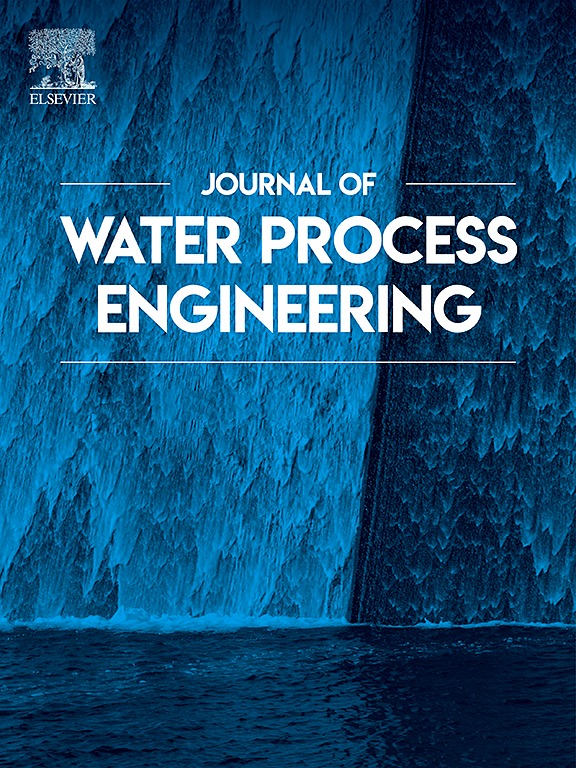Flow velocity-dependent methane emissions in sewage pipelines: Mechanistic insights from substrate metabolism to microbial trait dynamics
IF 6.3
2区 工程技术
Q1 ENGINEERING, CHEMICAL
引用次数: 0
Abstract
Urban sewer networks contribute significantly to greenhouse gas emissions through methane release, but the mechanisms controlling these emissions, particularly how flow velocity affects them, remain poorly understood. This study systematically investigated the impacts of flow velocity on methane emissions in sewage pipelines and revealed the underlying mechanisms through multiple analytical approaches. Results demonstrated that increasing flow velocity from 0.4 to 0.8 m/s significantly reduced cumulative methane production by 72.9 % within 72 h, with methane emission flux decreasing from 0.292 to 0.127 mg/(m2·h). Three-dimensional fluorescence spectroscopy analysis revealed that higher flow velocity limited substrate consumption, as evidenced by Region-IV fluorescence intensity being 48.1 % higher at 0.8 m/s than at 0.4 m/s. Microbial analysis showed that higher flow velocity significantly altered community structures, reducing key functional bacteria (e.g., Tolumonas decreased from 2.85 to 2.14 %) and methanogens (e.g., Methanobacterium decreased from 24.45 to 22.03 %), while diminishing community resilience and functional complementarity. Moreover, functional gene analysis further demonstrated that higher flow velocity downregulated genes involved in substrate hydrolysis (e.g., pgm), volatile fatty acids synthesis (e.g., porA), and methane production (e.g., mcrA). Correlation analysis identified flow-induced changes in microbial community composition as the primary driver of methane production variability. These findings provide novel insights into flow velocity-dependent methane emission mechanisms in sewer systems.

污水管道中流速依赖的甲烷排放:从基质代谢到微生物特性动力学的机械见解
城市下水道网络通过甲烷释放对温室气体排放做出了重大贡献,但控制这些排放的机制,特别是流速如何影响它们,仍然知之甚少。本研究系统研究了流速对污水管道甲烷排放的影响,并通过多种分析方法揭示了其潜在机制。结果表明:当流速从0.4 ~ 0.8 m/s增加时,72 h内累计产甲烷量显著降低72.9%,甲烷排放通量从0.292 mg/(m2·h)降低到0.127 mg/(m2·h);三维荧光光谱分析表明,较高的流速限制了底物的消耗,在0.8 m/s时,iv区荧光强度比0.4 m/s时高48.1%。微生物分析表明,较高的流速显著改变了群落结构,降低了关键功能细菌(如Tolumonas从2.85%降至2.14%)和产甲烷菌(如Methanobacterium从24.45%降至22.03%),同时降低了群落恢复力和功能互补性。此外,功能基因分析进一步表明,较高的流速下调了参与底物水解(如pgm)、挥发性脂肪酸合成(如porA)和甲烷产生(如mcrA)的基因。相关分析表明,水流引起的微生物群落组成变化是甲烷产量变异的主要驱动因素。这些发现为下水道系统中流速相关的甲烷排放机制提供了新的见解。
本文章由计算机程序翻译,如有差异,请以英文原文为准。
求助全文
约1分钟内获得全文
求助全文
来源期刊

Journal of water process engineering
Biochemistry, Genetics and Molecular Biology-Biotechnology
CiteScore
10.70
自引率
8.60%
发文量
846
审稿时长
24 days
期刊介绍:
The Journal of Water Process Engineering aims to publish refereed, high-quality research papers with significant novelty and impact in all areas of the engineering of water and wastewater processing . Papers on advanced and novel treatment processes and technologies are particularly welcome. The Journal considers papers in areas such as nanotechnology and biotechnology applications in water, novel oxidation and separation processes, membrane processes (except those for desalination) , catalytic processes for the removal of water contaminants, sustainable processes, water reuse and recycling, water use and wastewater minimization, integrated/hybrid technology, process modeling of water treatment and novel treatment processes. Submissions on the subject of adsorbents, including standard measurements of adsorption kinetics and equilibrium will only be considered if there is a genuine case for novelty and contribution, for example highly novel, sustainable adsorbents and their use: papers on activated carbon-type materials derived from natural matter, or surfactant-modified clays and related minerals, would not fulfil this criterion. The Journal particularly welcomes contributions involving environmentally, economically and socially sustainable technology for water treatment, including those which are energy-efficient, with minimal or no chemical consumption, and capable of water recycling and reuse that minimizes the direct disposal of wastewater to the aquatic environment. Papers that describe novel ideas for solving issues related to water quality and availability are also welcome, as are those that show the transfer of techniques from other disciplines. The Journal will consider papers dealing with processes for various water matrices including drinking water (except desalination), domestic, urban and industrial wastewaters, in addition to their residues. It is expected that the journal will be of particular relevance to chemical and process engineers working in the field. The Journal welcomes Full Text papers, Short Communications, State-of-the-Art Reviews and Letters to Editors and Case Studies
 求助内容:
求助内容: 应助结果提醒方式:
应助结果提醒方式:


